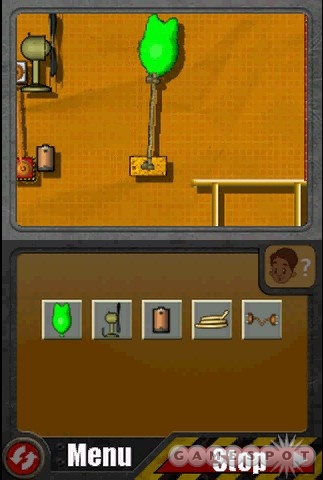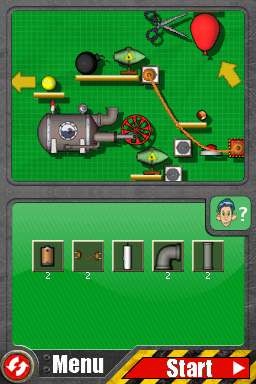Efficiency be damned. When confronted by a balloon that needs to be popped, you could just squeeze the darn thing until helium bursts forth from an open orifice, but where would the fun be in that? By constructing an elaborate machine complete with candles, conveyor belts, and even electrical switches, you can take the time to give that balloon a proper send-off. I Heart Geeks revels in the concept of building elaborate machines to perform mundane tasks, and the rush you feel when you successfully link seemingly random pieces together to do your bidding taps into the inventor buried deep inside everyone. But that simple pleasure is often displaced by poor help implementation and an assortment of tools that rarely excite the imagination. I Heart Geeks struggles to maintain its puzzling appeal, resulting in a tired exercise in mechanical tomfoolery.
In between the puzzle solving that makes up the majority of the experience, I Heart Geeks features a cursory story to explain why you're performing such odd activities in the first place. You follow a group of geeks (an enterprise?) as they try to turn the tables on the bullies who have tormented them through the years. It's a concept that could have been fun to see played out in vignettes if the material were good, but there are few clever ideas to keep you interested in the geeks' rise to overthrow their oppressors. Granted, the plot is only a small aspect of this game, but this lack of creative spark trickles down to every other element. From the bland artistic style and repetitive score to the predictable tools you work with, I Heart Geeks achieves the bare minimum similar games have reached while offering few noteworthy elements to separate it from the pack.
The rules are easy to learn. A set of immovable objects is located on the top screen, and you have to move the items located in your lower screen inventory beside them to solve a conundrum. Inventory items are chosen for you beforehand, and most of the levels are designed so you make use of your entire repertoire, though imaginative tinkering can let you pass with a bit of flair. In the early going, objectives stray toward the easy side to ease you in gracefully. You may have to lay out wooden planks or a spring pad so a ball can reach a box on the other side of the level, and there isn't a time limit rushing you through the process. You can take your time surveying the level, deliberately placing items using the touch screen, and then set things in motion so you can see how the items interact. Make a mistake? It's easy enough to tweak the items you placed, so simple trial and error is enough to solve most puzzles. You're ultimately graded on how quickly you finish each puzzle, but because there's no online integration, you won't be able to see how you rank against the best builders in the world.

New items are introduced at a steady clip so you can't become complacent. Spring pads and planks give way to fans and mirrors, and with a few dozen doodads to work with, there are a good variety of puzzles to solve. However, although your ultimate goal changes from level to level, there is little in the way of surprises to keep you invested. Each item has a specific purpose, so once you learn that a sponge can soak up water, you usually perform the same basic action with it whenever you find it in your inventory. Batteries are used to power electrical items, candles fuel steam engines, scissors cut ropes, and so on, so your job is to figure out where to place these items rather than construct cunning uses for them.
Much of the challenge comes in the exact placement many puzzles demand. For instance, in one level, you have to lay out seven magnets to get a metal ball to travel across the screen and land in a crate. It's a simple idea, and the pathway is obvious enough that you should have a rough approximation of a solution the first time you plop down your magnets. But getting everything in the perfect position takes lots of tedious fiddling. You might need to move one magnet a nanometer farther back or slightly change the angle of another, and figuring out the exact layout is aggravating, especially when you immediately spot the solution. This problem crops up often enough that it hinders your fun. The appeal of I Heart Geeks is seeing how wildly different mechanisms can be formed into a functioning machine. Having to focus on minute adjustments instead is tiresome.

This process could have been avoided if the help system were more… well, helpful, but its implementation is cumbersome. By tapping on an item in your inventory and then tapping on the head of an eager geek, you can see exactly where you should place it. Usually, as long as you get the item close to the designated spot, you should be all right, so this serves as a nice push when you're stumped. However, in cases like the aforementioned magnet situation that require extreme precision, the tip doesn't provide much relief since the ghost image showing you where to place the item disappears as soon as you remove the stylus from the geek's head. Furthermore, connecting items, such as ropes and electrical wires, aren't included in the tips, so you may have to guess where to place them. Most troubling of all is that there are times when the help is actually wrong. You may fail even if you follow the advice, which is utterly maddening if you've been banging your head against the wall for the last hour. With no way to skip a puzzle if you're stumped, the dodgy help system is a serious detriment.
The single-player game stretches on for more than 100 mind-bending stages, and you can challenge a buddy to some head-to-head action on those same puzzles if you want to prove just how fast you are. It's a weak multiplayer mode considering that the levels are recycled and you still need two separate cartridges, so it doesn't add much longevity to the package. I Heart Geeks is overpriced at $30, considering the wealth of similar and far cheaper games out there, and it doesn't warrant the higher price tag in the slightest. Predictable items fail to make the puzzles exciting, and the ho-hum aesthetics hardly mask the other issues. Solving a tricky puzzle is still satisfying, but you'll have more fun trying to pop a balloon in real life than crafting contraptions in I Heart Geeks.